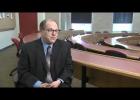Labor Relations Law
It is no small feat to strike the right balance in the classroom. As I evaluate my own approach to teaching, there's a quote by John Dewey, a leading educational reformer in the early 20th century, to which I always return: 'The practical problem of the teacher is to preserve a balance between so little showing and telling as to fail to stimulate reflection and so much as to choke thought.'
The course is an upper level, elective course that meets requirements for a Carnegie Integrated Course, with elements of all three Carnegie apprenticeships integrated into the course.
Course objectives:
- Students will develop core knowledge in the area of private sector labor relations law, focusing on the National Labor Relations Act, and including practice and procedure before the National Labor Relations Board
- Students will draft and file unfair labor practice charges and draft and file motions and briefs as if before the National Labor Relations Board
- Students will manage and understand a union organizing campaign from management and union perspectives
- Students will engage in creative lawyering to achieve management and union objectives
- If students choose to unionize, they will draft and negotiate a collective bargaining agreement
Development history: I have taught this course continuously since 1995. I have layered on various components of the course over its many iterations. The primary changes in the course have related to adding an electronic component (TWEN/Lexis Blackboard) in 2000 and studying student participation in the course and developing student outcomes and measurements (continuously since 2001). Some early lessons learned and development history of the course is detailed in Roberto L. Corrada, A Simulation of Union Organizing in a Labor Law Class, 46 J. L. Educ. 445 (1996), attached.
10-45 students per semester
Regularly taught since 1995
My course in Labor Relations Law is an upper level, elective course. I have taught the course as a whole course simulation more than ten times since 1995. The course is innovative in allowing students to organize and elect a union to represent them in negotiations with the professor over the terms and conditions of the course. The course maps to all three Carnegie- identified law school apprenticeships: 1) Cognitive/Analytical (the course is taught using traditional socratic inquiry and case method approaches to impart basic knowledge about labor law doctrine); 2) Expert Practice (students file unfair labor practice charges, motions, and briefs, engage in oral advocacy, and negotiate a labor contract); 3) Professional Ethics/Identity (this apprenticeship is only now being developed in an explicit way, but the simulation raises implicit and explored questions about the role of students as advocates, lawyers, union representatives, employer representatives facilitating a continuing dialogue about role and legal/ethical obligations throughout the course). I teach the course this way because I realized after about three years of teaching the course in the traditional way at the University of Denver that none of my students had the sufficient work background (blue collar, industrial) to really understand the context surrounding the cases in the textbook, in particular, the subtleties of the power relationship between employer and employee. I thought students might get the required contextual understanding if the classroom could be analogized to the workplace.
This course requires lecture, socratic inquiry, cooperative learning, peer teaching, and group discussion, all in the context of a simulation. The course does not have set assignments. The professor provides an overall context for the simulation, but the students push the simulation creating the problems that arise and then serve as the basis for assignments. The professor sets up scaffolding creating the overall conditions of an ill structured problem that is developed throughout the course. For example, over the past several years the course has explored in-depth issues related to bargaining units (multiple units, professional units), the limits of union organizing using email or websites, and collective bargaining. For more on ill-structured problem theory, see David H. Jonassen, Instructional Design Models for Well-Structured and Ill-Structured Problem-Solving Learning Outcomes, 45 EDUCATIONAL TECHNOLOGY RESEARCH & DEV. 65-94 (1997). Students file unfair labor practice charges, election petitions, motions, briefs, and take examinations. They also engage in a variety of oral advocacy including giving election speeches and arguing motions. If a union is elected, the students engage in collective bargaining. Feedback is provided online and in class. Assignment: A sample examination question is attached.
Evidence of student learning includes student work product (unfair labor practice charges, motions, briefs, collective bargaining agreement, and examination results), secret discussion board (student organizing discussion board), and focus groups. Students have gone on to positions as attorneys for the National Labor Relations Board and into labor and employment-related fields. I am currently studying differential student learning based on exam questions relating to simulation and non-simulation based examination questions.


